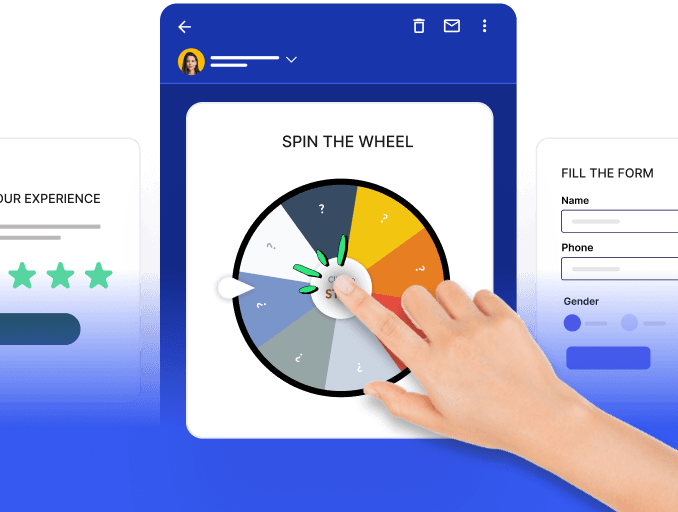If your online store is not getting the customer engagement or conversions that you thought it would, you may have some optimizations to do. It's important to identify what doesn't sit well with your store visitors and what changes can be made to improve their experience. This is where A/B testing comes in.
A/B testing allows you to test and analyze different versions of your website or landing page to see which one performs better. In this article, we will explore the importance of A/B testing for your shopify store and provide a step-by-step guide on how to effectively conduct A/B tests to increase conversions and engagement.
Table of Contents
What is A/B testing?
A/B testing, also known as split testing, is a method of comparing two versions of a webpage or element to determine which one performs better for your target audience. It involves randomly dividing your website visitors into two groups and showing them different versions of a page. By analyzing the behavior and response of each group, you can identify which version is more effective in terms of conversions, engagement, or any other predefined metric.
Why use A/B testing on shopify to boost up conversions?
A/B testing is crucial for optimizing various aspects of your online presence, yielding significant benefits. Here are some key reasons why you should try A/B testing for your shopify store:
1. Improve engagement: A/B testing allows you to experiment with different content formats, layouts, and styles, helping you identify what resonates best with your audience ultimately reducing the bounce rates and retaining visitors.
2. Boost conversion rates: By experimenting with different variations, you can identify which version of a CTA or copy resonates better and is more effective in making your visitors perform an action. Once identified, you can implement the changes that lead to higher conversion rates.
3. Reduce cart abandonment: A/B testing in your Shopify store allows you to optimize the checkout process. This helps in reducing cart abandonment and improving the overall shopping experience.
4. Increase subscriptions/opt-ins: Testing different incentives, placements, and messaging for your subscription or opt-in forms enables you to discover the most effective approach. A/B testing empowers you to optimize these elements, leading to increased subscriptions and opt-ins.
How to do A/B testing on Shopify
Now that we understand the importance of A/B testing, let's dive into the step-by-step process of conducting A/B tests on Shopify.
Step 1: Set objectives and metrics for A/B testing
Before you start A/B testing, it is crucial to establish a clear and concise set of objectives and metrics for the A/B testing process that will serve as the accuracy mark for measuring success. Take the time to identify your goals and determine the specific metrics that will be used to gauge progress. For instance, if your aim is to enhance conversion rates, you could set a metric of a 10% increase in conversions. By setting these parameters, you will have a solid foundation upon which to base your testing and make informed decisions.
Step 2: Identify elements for A/B testing
In order to optimize your website or landing page, it is crucial to identify and analyze the various element. Some elements you can A/B test are:
headers
images
call-to-action buttons
color schemes
layout
These elements can influence user behavior. It is advisable to create a comprehensive list of these elements and then prioritize them based on their potential impact on the overall user experience.
Step 3: Design and execute the A/B test effectively
Choose and install A/B Testing tool: Consider using options like Optimizely or VWO to create and run A/B tests for your Shopify store. The Shopify App Store also offers more A/B testing tools to choose from
Create variations: Develop variations labeled descriptively for easy analysis. Use an ads manager, email platform, or website A/B testing tool.
Select the audience: Choose to serve the A/B test to the entire audience or a subset. Audience selection depends on the hypothesis and desired data gathering speed.
Run the test: Run the A/B test for at least two weeks to ensure reliability. Avoid running multiple tests on the same webpage or audience simultaneously.
Step 4: Analyze the results of your A/B tests
After running your A/B test for a sufficient period of time, use the metrics you established to evaluate the performance of each variation. Look for statistically significant differences in conversion rates, bounce rates, or any other relevant metrics. This analysis will provide insights into which elements are effective and guide your decision-making process for further optimization, including detailed analytics.
Methods and techniques for A/B testing for your shopify store
You can use these A/B testing methodologies to identify the elements that you should perform A/B tests on and optimize:
1. Technical analysis: Test how well your store functions across different browsers and devices for optimal user experience. This will help you identify the elements that make your page slow.
2. On-site surveys: Implement surveys that pop up on your website to gather qualitative data from visitors, addressing potential barriers to purchase.
3. Customer surveys: Send comprehensive surveys to customers focusing on their problems, hesitations, and language preferences.
4. Analytics analysis: Use analytics tools to ensure accurate tracking and understand visitor behavior like what makes them click or degress to another website and identifying conversion funnel leaks.
5. Session replays: Watch real visitors interact with your site to identify areas of difficulty, frustration, or confusion in their journey.
Best practices for A/B testing on Shopify
To ensure the success of your A/B tests on Shopify, here are some best practices to keep in mind:
1. Start with the highest-impact elements: Focus on testing elements that are likely to have the greatest impact on your conversion rates or user experience. This will help you prioritize your efforts and achieve quicker results.
2. Test one element at a time: To accurately measure the impact of each element, test them individually. Testing multiple elements simultaneously can make it difficult to attribute any changes in performance to a specific element.
3. Ensure a large enough sample size: To obtain reliable results, make sure you have a sufficient number of visitors participating in your A/B test. Shopify provides tools that can help you calculate the required sample size based on your current conversion rate and desired minimum detectable effect.
4. Run tests for a sufficient duration: Run your A/B tests for a long enough duration to capture different traffic patterns, including weekdays, weekends, and holidays. This will help ensure that your results are not skewed by external factors.
5. Continuously iterate and optimize: A/B testing is an iterative process. Once you have identified a winning variation, continue to test and refine your website or landing page to achieve even better results. Keep testing new ideas and strategies to stay ahead of the competition.
6. Shift focus from wins to insights: Focus on gaining insights that can be applied to future tests and business areas instead of just which variation won.
7. Emphasize segmentation: Analyze results by segmenting data into categories such as new visitors, returning visitors, device types, and sources. Look beyond overall outcomes to discover insights specific to each segment.
8. Deep dive into segmented insights: Examine if a variation performed well within specific segments. The hypothesis may still hold true for certain audiences, providing valuable information for future optimization.
Tools to use for A/B testing on for Shopify
There are several tools available to help you conduct A/B tests on your Shopify App store. Here are three popular options:
| Tool | Pricing |
|---|---|
| Optimizely | Available for free Premium plans starting from $149 per month |
| VWO | Available for free Premium plans starting from $271 per month billed annually |
| Kameleoon | Starting approximately $3,000 per year |
| Lomio | Premium plans starting from $19/month for stores upto 100 monthly orders |
| Trident AB | Available for free Premium plans starting $13.99 per month |
1. Optimizely:
Optimizely is a cutting-edge A/B testing tool that stands out for its user-friendly interface and robust experimentation capabilities. Optimizely distinguishes itself with a strong focus on user experience and accessibility. Its visual editor and emphasis on statistical significance make it an excellent choice for both beginners and experienced users. The emphasis on personalization extends its utility beyond traditional A/B testing. Key features include:
Visual Editor: Simplifies the A/B testing process with an intuitive drag-and-drop interface, making it accessible for users with varying technical expertise.
Statistical Significance: Provides robust statistical analysis to ensure the reliability of test results, allowing users to make confident data-driven decisions.
Personalization: Goes beyond A/B testing with advanced personalization features, enabling tailored experiences for different audience segments.
2. VWO (Visual Website Optimizer):
VWO is a versatile A/B testing tool known for its comprehensive set of features and powerful testing capabilities. The inclusion of multivariate testing and rich visual insights through heatmaps and session recordings gives users a comprehensive understanding of user behavior. Advanced targeting options enhance the precision of experiments, making VWO a versatile choice for optimization efforts. Key features include:
Multivariate Testing: Allows users to test multiple variations simultaneously, providing a deeper understanding of how different elements impact user behavior.
Heatmaps and Session Recordings: Offers visual insights into user interactions with heatmaps and session recordings, facilitating a more holistic analysis of user engagement.
Advanced Targeting: Enables precise targeting based on various parameters, ensuring that experiments are conducted on specific audience segments.
3. Kameleoon:
Kameleoon is a powerful A/B testing tool designed to elevate your digital optimization efforts. With its user-friendly interface and robust features, Kameleoon enables businesses to effortlessly compare and analyze different variations of web content, allowing for precise insights into user behavior and preferences.
Personalization: Kameleoon allows for advanced website personalization, tailoring content based on user behavior and preferences.
Segmentation: Efficiently target specific audience segments with tailored experiences for improved engagement.
Conversion tracking: Track and analyze conversion rates to assess the impact of changes on user behavior.
Multivariate testing: Conduct multivariate tests to optimize combinations of various elements simultaneously.
Real-time editing: Make real-time changes to web content without requiring code modifications.
4. Lomio:
Lomio is a cutting-edge A/B testing tool designed to empower businesses in optimizing their digital assets. With a user-friendly interface, Lomio allows marketers and developers to effortlessly create and compare different versions of webpages or applications. The tool is a valuable resource for businesses seeking data-driven decision-making to enhance their online performance and achieve optimal results through iterative testing and optimization.
Dynamic content: Lomio facilitates dynamic content changes, enabling personalized user experiences for improved engagement.
User segmentation: Segment users based on behavior, demographics, or other criteria for targeted testing.
Conversion rate analysis: Analyze conversion rates to gauge the effectiveness of variations in user interactions.
A/B/n testing: Beyond A/B testing, Lomio supports A/B/n testing, allowing for testing multiple variations concurrently.
Behavioral insights: Gain insights into user behavior and preferences to inform testing strategies.
5. Trident AB:
Trident AB specializes in A/B testing services, helping businesses optimize their online presence. Leveraging data-driven insights, they assist clients in making informed decisions to achieve higher performance and maximize their digital impact. Its features include
Split testing: Conduct traditional A/B tests to compare two variations and determine the most effective.
Statistical significance: Trident AB provides statistical significance metrics to ensure confidence in test results.
Automated testing: Streamline the testing process with automated features for efficiency and accuracy.
Conversion funnel analysis: Evaluate the entire conversion funnel to identify and address potential bottlenecks.
Responsive design testing: Test variations across different devices and screen sizes for a comprehensive analysis.
Conclusion
A/B testing is an essential practice for optimizing your Shopify store and improving your conversion rates. By testing different variations of your website or landing page, you can identify the elements that have the greatest impact on user behavior and make data-driven decisions to improve your performance.
Remember to set clear objectives, test one element at a time, analyze the results of your buyer's journey, and continuously iterate and optimize. With the right tools and strategies in place, A/B testing can help you achieve significant improvements in your Shopify store's performance and drive more conversions.







